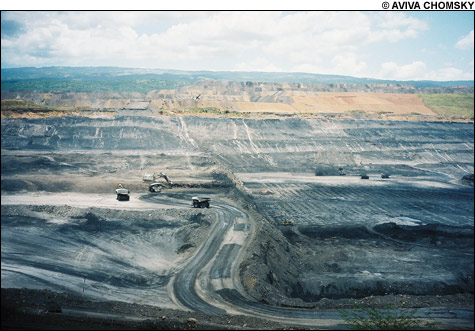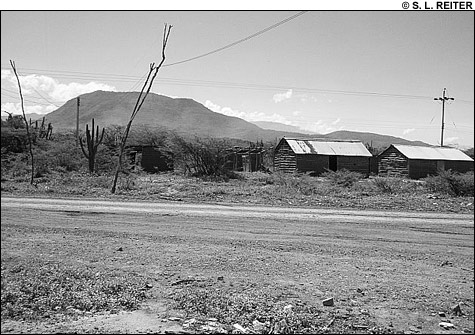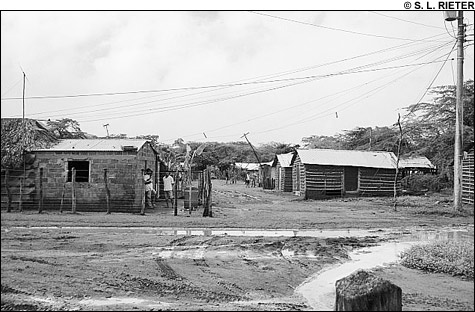The North Shore Colombia Solidarity Committee Blog
See our home page.(Our old blog on tripod.com is still active, but it is now also appended to the archives of this blog.)
Monday, October 01, 2007
The dirty story behind local energy
http://thephoenix.com/Article.aspx?id=48183&page=1 Eastern Massachusetts hums comfortably on Colombian coal. But the mines are devastating land and lives in the Guajira peninsula. By: AVIVA CHOMSKY 10/1/2007 10:28:47 AM
Aviva Chomsky is a professor of history and coordinator of Latin American, Latino, and Caribbean studies at Salem State College, and the co-editor of The People Behind Colombian Coal: Mines, Multinationals, and Human Rights. She has led three delegations to the Colombian coal region, most recently in August 2007. She can be reached at achomsky@salemstate.edu.
Six years ago, Albania’s newest arrivals led a different sort of life in a town that has since been wiped off the map. They were farmers, largely self-sustaining, who supplemented their living with cash from surplus crops of lemons, plantains, and grapefruit. Their lives were not idyllic, but neither were they wretched. The town they then called home was Tabaco. Today Tabaco is a memory, obliterated as it was on August 9, 2001, to allow for expansion of the world’s largest open-pit coal mine. On that day, employees of the Cerrejón Zona Norte mine — supported by armed security guards, the national police, and the army, which dragged some residents from their homes by force — leveled the town with bulldozers, evicting Tabaco’s 700 residents and razing its every structure. The coal from that mine now fires power plants in the Bay State. Anytime anyone in Eastern Massachusetts flips on a light switch, there’s a better than 25 percent chance the illumination they enjoy comes as a result of the misery inflicted on the displaced residents of the now non-existent town. One of the people displaced by the massive, 30-by-five-mile Cerrejón mine was Aura Pérez, then age 70. “[Tabaco] was very beautiful,” she mourned in a videotaped testimonial, as she stood before the ruins of her house on that fateful August day. “There was plenty of food — the people here hardly ever got sick because everything was clean. There was a beautiful pond, unpolluted — this was what life used to be like here. It was very safe; you could go wherever you wanted, at any hour of the day or night. . . . Look how it’s all destroyed. They destroyed everything.” Some 100 of the people displaced on August 9 took refuge in Tabaco’s school, which had been left standing. When it was razed in January of 2002, they moved to a plot of land they had formerly farmed that had since been purchased by the mine. They slept in hammocks. In April, the mine company evicted them from there, as well. By November, Aura Pérez was dead. “She died of impotence,” says her brother José Julio Pérez, who also was displaced when Tabaco was destroyed. Aura Pérez was one of 14 people who died in the months after the village was evacuated. “When she became sick,” her brother explained, “there was no way to get the medicine she needed. We lost our homes, we lost our land, we lost our community, we lost our livelihoods — we lost everything.”
Another one bites the dust Under Colombian law, Afro-Colombian and indigenous communities can claim collective legal title to lands that they identify as ancestral lands. Although Tabaco’s residents have farmed the land around their former village for generations, they can’t pursue a legal claim because the land no longer exists — it has been swallowed up by the mine since Tabaco was displaced in 2001. That’s because Tabaco, in northern Colombia’s resource-rich Guajira peninsula near the Venezuelan border, sat on top of some of the hemisphere’s largest remaining coal deposits. In the 1980s — spurred on by both the high cost of mining and new environmental regulations that required lower emissions in the United States — the Exxon corporation opened Cerrejón Zona Norte. The country’s second-biggest mine, La Loma — owned by the Birmingham, Alabama–based Drummond Company — soon followed in neighboring Cesar Province. Today, Tabaco lies buried in the huge, gaping gash of Cerrejón. Its residents have scattered, and about 60 families have crowded into inadequate provisional dwellings in the town of Albania. The central plaza of Albania seems a cheerful place. It’s ringed with stores, restaurants, and bars, and bustles with activity, conversation, and strains of music. The air, though, is filled with a fine-grained dust that permeates everything, especially when the wind is blowing in the wrong direction. Tourists rarely go to Albania, and if they did, there would be no reason for them to spend much time there. If you do stay for more than a day or two, however, you begin to wonder: why aren’t the children in school? Why aren’t the adults working? Driving into town, you pass a large billboard advertising ALBANIA: THE BLACK PRINCESS OF LA GUAJIRA. Behind the words, you see two possible interpretations for the appellation. One is the smiling faces of people, obviously of African origin, who seem to be representing the province or the town. The other is the coal mine. Under the land of Albania, and the whole region surrounding it, is coal. Lots and lots of coal. Coal mining is dirty business. Underground coal mines pose huge risks to the people who work in them: explosions, accidents, cave-ins, and poisoned air have killed thousands of coal miners over the years. Just this past month, six miners died trapped underground at the Crandall Canyon Mine in Carbonville, Utah, while three members of the rescue team were also crushed to death. As the rescue attempts continued at Crandall, three more were killed in a coal-mine accident in Indiana. Surface, or open-pit, mines pose different risks. Whole ecosystems are destroyed when miles of land are dug up to access the coal underneath it. In the Guajira, rivers and streams have been diverted, desertification has spread, and whole species — such as the iguana and the howling monkey — have disappeared or been supplanted. Too often, these ecosystems include people who are simply deemed dispensable by the mining companies, the power companies that buy the coal, and the consumers of electricity produced by the power companies. In Colombia, these are indigenous Wayuu and Afro-Colombian people who have inhabited the desert of La Guajira for hundreds or even thousands of years. And among those who benefit from their displacement might well be you. The Cerrejón coal mine has been operating in the region since the 1980s, extracting more than two million tons of coal a month. All of the coal is exported, 20 percent to the United States — most of it to fire East Coast power plants. Massachusetts is the only New England state to rely heavily on coal for producing electricity. One-fourth of its electricity comes from burning coal, in three separate plants: the Mount Tom plant in Holyoke, the Salem Harbor plant in Salem, and the Brayton Point plant in Somerset. (Although Rhode Island itself uses no coal, the Brayton Point plant, on the Massachusetts–Rhode Island border, is the largest source of pollution in that state.) East Coast industries and power plants used to rely on coal brought in by rail from Appalachia and the southeastern US. But beginning in the 1970s, environmental regulations started requiring power plants to lower their emissions. The idea behind the legislation was for plants to upgrade their equipment and install scrubbers that would catch toxic particles (sulfur dioxide and nitrogen oxide) during the burning process. But many plants found that they could reduce their emissions by simply switching to higher-quality, cleaner-burning coal, such as could be found in the open-pit coal mines of the western United States. By the 1980s, two major US energy companies, Exxon and Drummond, were exploring another source: Colombia’s vast, untapped, and clean-burning coal deposits. Soon these two companies were shutting down their US mines to shift production to Colombia. Not only was its coal clean, it was inexpensive: government subsidies and cheap labor provided an important incentive. And Massachusetts plants soon had another reason to make the switch: it’s actually cheaper to ship the coal by sea from Colombia to the ports of Massachusetts than it is to move it by rail from mines in Illinois and Wyoming.
Postcards from the edge Although the coal from this region powers electricity here in Massachusetts, as well as much of the rest of the US and Canadian Eastern Seaboard, Europe, Israel, and Japan, Colombians see the coal only in the displacements, the contaminated air, and the scars on their land. The indigenous Wayuu village of Tamaquito has no electricity, nor health services, running water, or schools. It is surrounded by fertile farmland, where community members used to plant their own crops and find work on surrounding ranches. Tamaquito’s children used to attend primary school in Tabaco. Now the company has bought all of the farmland, leaving the village an isolated island. “Tamaquito is a very, very poor indigenous community,” explains Jairo Dionisio Fuentes Epiayu, the native governor. (Tamaquito is governed by traditionally elected authorities.) “We are suffering a lot here because the mine has completely surrounded us. We don’t have access to the roads to move or leave our village. We have to walk on trails, and it takes four or five hours to get to Patilla [the nearest village]. This means we don’t have access to anything. Cerrejón won’t even let us on its property to hunt. We used to support ourselves by hunting, by planting, but now that Cerrejón has bought up everything around it, we have no way of surviving.” Cerrejón’s slogan is “Coal for the world, progress for Colombia.” It’s repeated on the company’s Web site, in its advertisements, and on billboards ubiquitous in the province. Eder Arregocés, a community leader from Chancleta, takes an ironic view of these oft-repeated words. “If that is so, I’d like to know, to what country do the towns of Chancleta, Roche, and Tabaco belong? There are droves of young people just wandering around because there is no school, there is no work. It may be one of the largest coal mines in Latin America, but most families here eat one meal a day.” “At first we believed what they said, that the mine would bring progress for Colombia,” adds Inés Arregocés, another villager displaced from Tabaco. “But now we see that it’s sadness and destruction for Colombia, because we were displaced from our homes, from our lands. . . . They are dumping huge piles of earth where our houses, our streets, our schools used to be. And now it’s just giant mountains of dirt, contamination, and suffering for us.” “We’ve gone from being a productive community,” adds Wilman Palmezano of Chancleta, “to a community of paupers.”
Silver and coal Most of the mine’s 5000 direct employees and 5000 subcontracted workers also benefit from the mine’s presence. The majority of the direct employees have a significant level of technical training, and work operating heavy machinery or in the machine repair shops. They don’t live in Mushaisa — that’s reserved for high-level management. But neither do they live in the impoverished villages around the mine. Most of them come from cities like Barranquilla and Valledupar, where they had access to higher education. A job at Cerrejón is a good job by Colombian standards. Although the pay is far less than a comparable job would pay in the United States, but workers enjoy a strong union, health and education benefits, and pensions. Subcontracted workers are generally not so well-off. They aren’t covered by the union contract, and their jobs are lower-paid and often temporary. Still, a job is a job, and, in a country with a poverty rate of 50 percent and unemployment ranging from 10 to 20 percent in recent years, a job is not to be sneezed at. The company’s profits flow around the world. Coal is now Colombia’s second largest legal export, following oil, and Cerrejón’s exports represent an important source of foreign exchange for Colombia. The company pays royalties of more than $100 million US dollars a year to the Colombian government, much of which is returned to local municipalities. The profits also flow into the coffers of the three multinationals that own the mine, benefiting their employees and executives. And Cerrejón pays out more than half a billion dollars to its shareholders every year. In 2005 it reported close to $450 million in retained profits. The communities affected by the mine got a much smaller compensation from the company’s operation: Cerrejón spent just $2 million in its “communities division.” Even that relatively paltry sum never seems to make it to the people for whom it is earmarked, complain the residents. Most of the money, they say, ends up in the hands of corrupt officials. Cerrejón admits that its royalty payments often fail to reach their prescribed destinations, and in July 2006 implemented an oversight commission to monitor its distribution. The commission has not issued any public report. The company has also, obliquely, admitted that its comportment in the displacement of Tabaco was unacceptable. “We realize that mistakes were made in the case of Tabaco,” said Cerrejón president León Teicher. In Cerrejón’s 2006 Sustainability Report, the company explained that one of its corporate goals is to “prevent the displacement of individuals, groups and communities.” These words ring a bit hollow to Tabaco’s former residents.
Safety hazards The victim’s families have brought their case before a US court, with the help of the United Steelworkers and the International Labor Rights Fund. An Alabama jury voted in July that there was insufficient evidence to prove that Drummond was behind the killings. The plaintiffs plan to appeal, arguing that the judge disallowed two of their most important witnesses. Upon hearing the verdict, Ávila commented: “The value of my life has just dropped dramatically. If the company gets away with killing Locarno and Soler, why not just get rid of me, too?” Working conditions at Drummond’s La Loma mine are significantly worse than at Cerrejón. Wages are lower, and health and safety conditions poorer. Workers complain that Drummond’s vaunted “efficiency” tactics severely compromise their health. At a meeting with an international delegation this past summer, union workers explained that Drummond’s system of extracting huge boulders uses a conveyor belt–apron feeder system to drop them into trucks, where the drivers are repeatedly jolted and shaken by the impact. Severe spinal-cord injuries are common. According to the union, more than 150 truck drivers have been injured in this manner, 15 of whom have been permanently disabled. “The company won’t let us see a doctor until our seven-day shift is over,” one worker complains. “Then the company doctor always says there is nothing wrong and makes us go back to work.” In addition, workers say they’re afraid to report injuries, because the company will simply fire them. Communities in the vicinity of the Drummond mine face the same poverty, displacement, and environmental contamination as those near Cerrejón. In the town of La Loma, where most workers retreat to sleep after their 12-hour shifts, they frequently find that there is no water or electricity. “We’re not against coal mining,” says José Julio Pérez, the president of the Tabaco displaced villagers’ committee (and the brother of the late Aura Pérez), who now lives with his wife and five children in a two-room shack in Albania. “We just want the mine to compensate us for the damage it has caused. We’re asking the mine to relocate our community. We just want it to respect our human rights.” Bridging the gap But environmental organizations such as HealthLink, a North Shore group founded in 1997 in response to concerns about contamination from Salem’s coal-fired power plant, take a somewhat different view. They believe that switching to a different kind of coal is a Band-Aid solution, or perhaps even a way of evading environmental laws. “In Massachusetts, Colombian coal is a way for Dominion to delay having to install costly capital equipment to meet our state’s clean-air regulations,” says HealthLink founder Lynn Nadeau. In addition, as its name suggests, HealthLink takes a holistic approach to the impact of fossil fuels and the true cost of coal to our society. Shifting coal mining to Colombia doesn’t reduce environmental destruction — it just relocates it. “Colombian coal exploits cheap labor and causes vast environmental degradation [there],” adds Nadeau, “making many areas uninhabitable.” Since 2001, a small group of coal consumers in Massachusetts and elsewhere have pressed Cerrejón — as well as the power companies that buy the coal — to change its treatment of local communities. Some of these Massachusetts residents have lobbied, met with mine and power-plant officials, and visited the Colombian mines to investigate the conditions for themselves. They have also invited union leaders and village representatives from Colombia to Massachusetts on numerous occasions. In Salem, the mayor and the city council have both advocated for the human rights of those affected by coal mining in Colombia. Salem’s mayor, Kimberly Driscoll, issued a statement after meeting with José Julio Pérez, declaring the city’s support for Tabaco’s relocation struggle. The Salem City Council also condemned the mine’s destruction of Tabaco and called for the town’s relocation to be “carried out promptly and effectively, so that the inhabitants of Tabaco can rebuild their community and lead productive, shared lives.” Dominion Energy has been a bit more reluctant to speak out publicly on the issue. Representatives from that company met with Pérez in March 2006 and issued a guarded statement the following month. “Dominion is sympathetic to the problems this village faces. We expect all of our suppliers — domestic and foreign — to adhere to all rules and regulations governing their operations. Dominion would like to see a just resolution to these issues,” it said. The power company formalized its position in a March 2007 letter to all of its coal suppliers, after a visit to the Cerrejón mine that same month. “At Dominion, we think it is important to periodically reinforce to our supply partners our position on ethical conduct and social responsibility,” the letter reads. “This simply means to try to work with regulators, employees, and those directly and indirectly affected by your operations with respect, dignity, and common decency,” including “negotiating in good faith with labor groups and interacting with stakeholders who are impacted by your operations.” Although the letter is careful not to accuse any supplier of violating these principles, it does warn that “it is Dominion’s intention to seek out like-minded suppliers who share our dedicated commitment to these values to be our supply partners.” The company declined, however, to join a fact-finding delegation, as well as several invitations to arrange independent meetings with the mine’s union or to visit the affected communities while in the region. In September 2007, Dominion reiterated that “we are still purchasing coal from South America.” Massachusetts residents who did participate in a fact-finding delegation (organized by this author and by the US-based grassroots organization Witness for Peace) to the mining region this past August took a much stronger view. “Now that I have met the people who are harmed by the mining of the coal that we use in New England, I understand that our lives are as closely connected as if we lived next door to one another,” says Boston-area resident Margey Colten. “I have learned that, whether we are consumers of Colombian coal or managers or shareholders of a mining company, we are all responsible for righting the wrongs that have been done to the people of the Guajira.” Adds Salem State College student Quin Gonnell, “We, as the consumers of this coal, should become aware of what is happening and hold our energy providers accountable for these blatant human-rights violations. Unlike those being starved and displaced in Colombia, we have a voice in this matter. We have the power to make a difference. . . . We must not remain apathetic to the thousands of lives being ruined on our behalf.” Aviva Chomsky is a professor of history and coordinator of Latin American, Latino, and Caribbean studies at Salem State College, and the co-editor of The People Behind Colombian Coal: Mines, Multinationals, and Human Rights. She has led three delegations to the Colombian coal region, most recently in August 2007. She can be reached at achomsky@salemstate.edu.
Copyright © 2007 The Phoenix Media/Communications Group |
Archives
July 2004 December 2004 August 2005 March 2006 May 2006 September 2006 October 2006 November 2006 December 2006 January 2007 February 2007 March 2007 April 2007 May 2007 June 2007 July 2007 August 2007 September 2007 October 2007 January 2008 February 2008 June 2008 July 2008 November 2008 December 2008 January 2009 February 2009 March 2009 April 2009 May 2009





